MYOPIA MANAGEMENT
FOR CHILDREN
nomy represents an innovative solution for the treatment of progressive children myopia. This method counteracts the increase of myopia by attempting to inhibit the length growth of the eye.
nomy represents an innovative solution for the treatment of progressive children myopia. This method counteracts the increase of myopia by attempting to inhibit the length growth of the eye.

The development of progressive myopia is a complex process that can be attributed to various causes – genetic and environmental.
For instance, a lack of time spent outdoors and excessive close-up activities can promote the development of myopia.
The development of progressive myopia can be promoted by the constant use of mobile devices or digital displays.
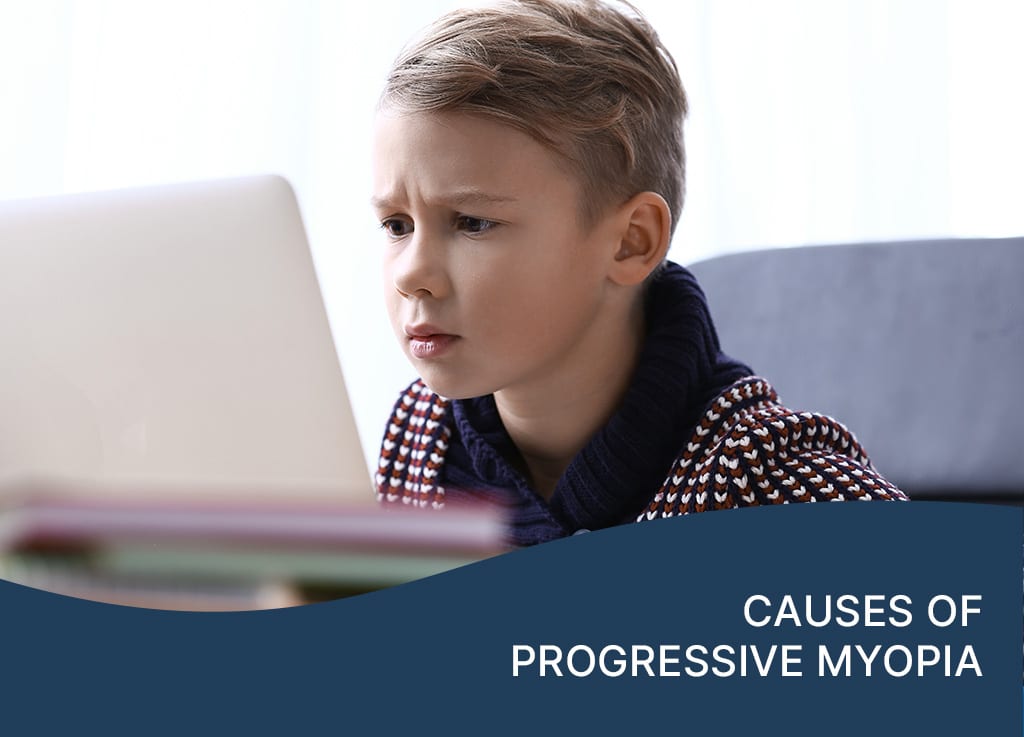
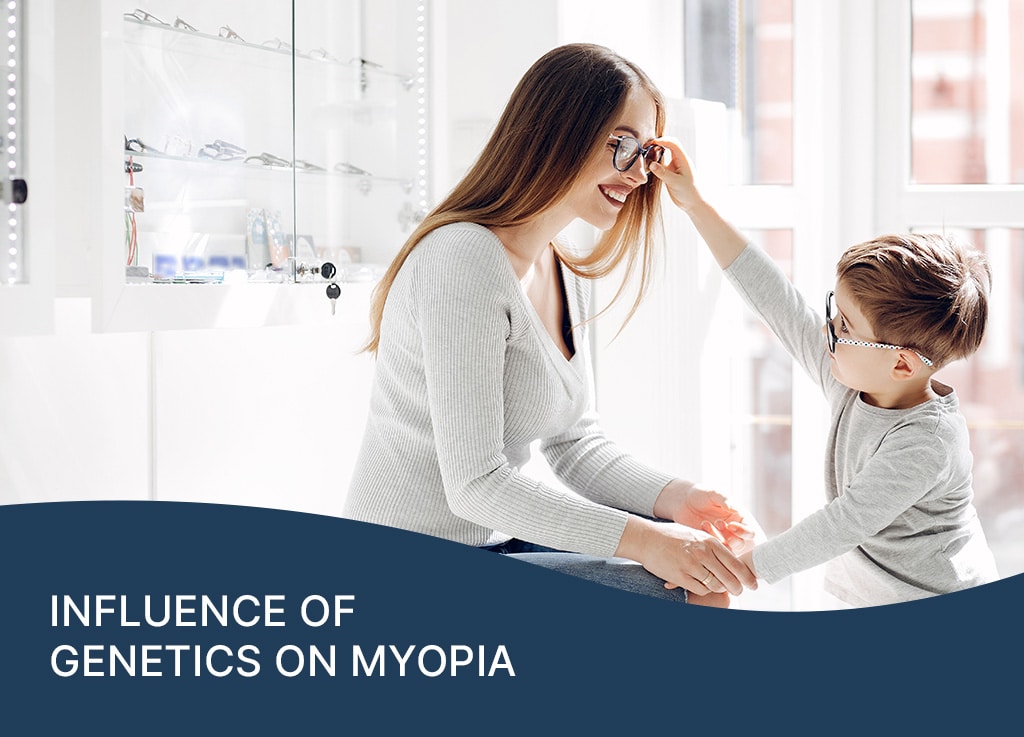
Intense reading and the excessive use of mobile devices are suspected of promoting progressive myopia because the view into the distance is neglected and the eye is stimulated to grow with the increased focus on near objects.
Genetic predisposition also often plays a crucial role: If one or even both parents already have significant myopia, the statistical probability increases that the child will also develop a high myopia.

In the first months of life, children‘s eyes usually exhibit hyperopia. This tends to balance out during the course of growth and the continuous changes in the eyeball during childhood.
The majority of eye growth occurs in the early years of life, after which this process slows down. Between the ages of six and nine, the average annual growth of an eye is about 0,16 mm. Between the ages of nine and twelve, it reduces to 0,08 mm. Between the ages of eleven and fourteen, the average growth is only 0,02 mm.1
It is therefore assumed that the average axial length growth during the entire period is 0,1 mm per year. Myopia develops when the axial growth of an eye is not in harmony with the changes in the cornea and the lens of the eye.
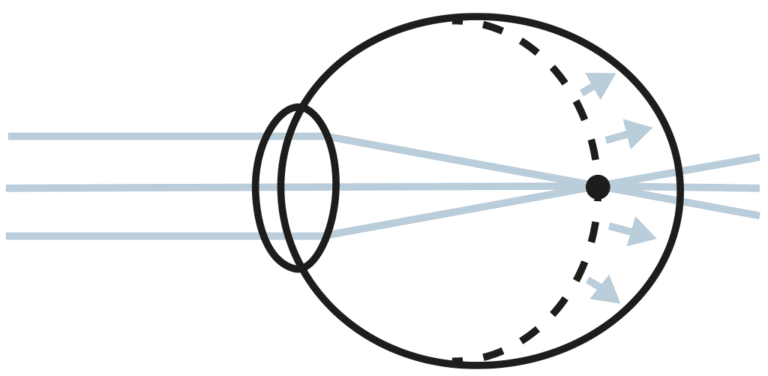

1Quelle: Mutti DO, Hayes JR, Mitchell GL, Jones LA, Moeschberger ML, Cotter SA, Kleinstein RN, Manny RE, Twelker JD, Zadnik K; CLEERE Study Group. Refractive error, axial length, and relative peripheral refractive error before and after the onset of myopia. Invest Ophthalmol Vis Sci. 2007.

A recent study estimates that 30% of the world‘s population is already myopic today. This figure is expected to rise to around 50% by 2050. This corresponds to an impressive five billion people.
Myopia will increase exorbitantly in East and Southeast Asia. The number of myopic people is already particularly high in countries such as South Korea, Taiwan, Singapore, China and Japan.
The number of people with myopia is also increasing in the USA. Current reports show an increase to 42%, which corresponds to a doubling within three decades.2
2 International Myopia Institute, https://myopiainstitute.org/myopia/
It is worth noting that, according to studies, not only the number of myopic people will increase, but myopia as such will also increase and high myopia will become more common.2
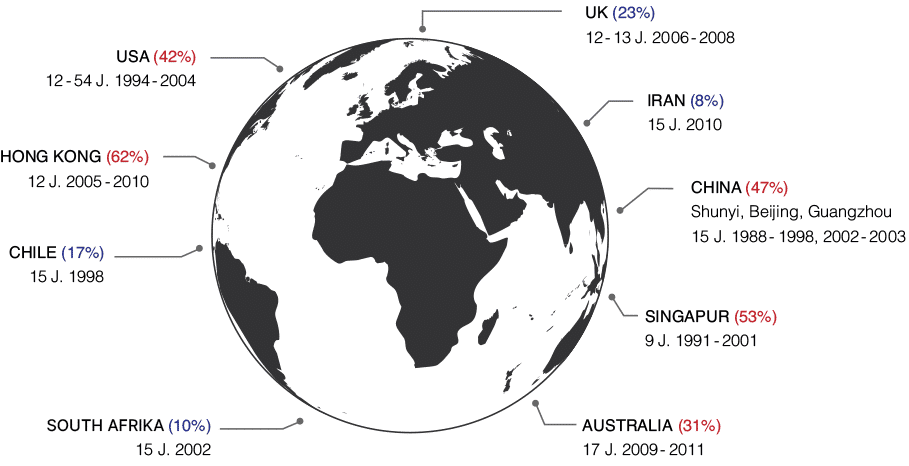
Almost 5 billion people will be myopic by 2050.2
Almost 1 billion people will be highly myopic by 2050.2
nomy lenses are innovative lenses that counteract the increase in short-sightedness (myopia) by trying to inhibit the lengthening of the eyeball.
nomy is based on the theory of peripheral hyperopic defocus. In myopic eyes the focal point lies in front of the retina, leading to blurred vision. To correct myopia, monofocal lenses with negative refractive power are typically prescribed which focus the images on the retinal plane. However, this correction occurs only in the region of the fovea, while the peripheral retinal focus remains lagging. It is suspected that this defocus in the peripheral retina may contribute to the growth of the eye. In contrast, nomy is specifically designed to fully correct the refractive error in the fovea, while inducing a myopic/positive defocus in the peripheral retina thereby slowing the linear growth of the eye. Through this defocus on the peripheral retina, the eye no longer receives the stimulus to grow. This defocus is achieved by a carefully designed distribution of positive refractive power at the periphery of the lens. No myopia treatment stops the growth of the eye completely. Rather, nomy helps to slow the progression of eye growth.
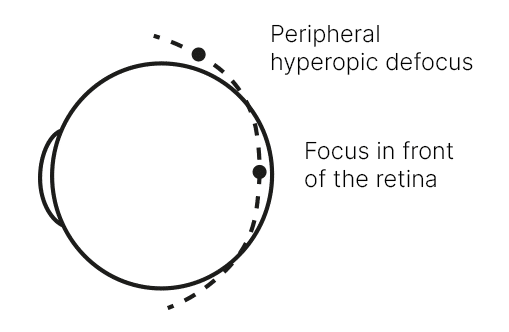
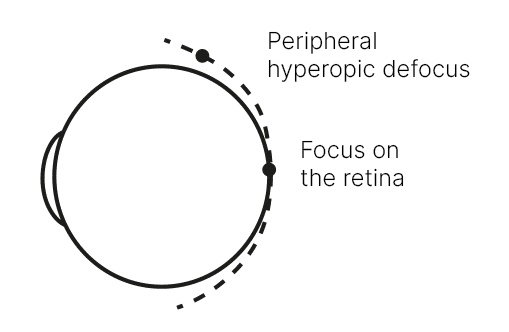
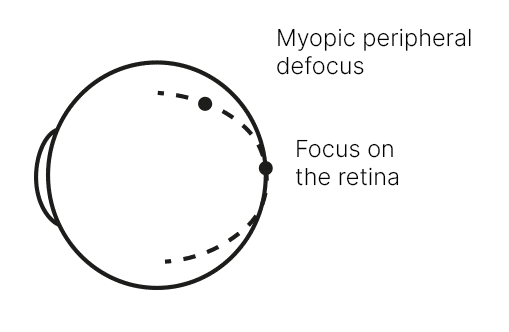
nomy targets the often asymmetric shape of the retina in myopic eyes: The higher positive refractive power in the lateral, temporal area of the lenses causes increased defocus in the nasal area of the retina. This adjustment aims to reduce the progression of myopia by addressing the nasal area of the retina, as this region is the one that drives eye growth under hyperopic defocus. The asymmetrically positive defocus on the back of the lenses takes into account the natural asymmetry of the retina and thus counteracts excessively rapid or strong eye elongation. Asymmetric blur does not improve the visual experience
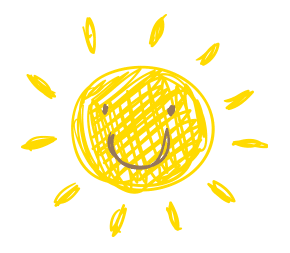
The nomy design offers a balanced visual experience that is optimised for far distance vision and near vision tasks. This is achieved through two main areas in the lens: An oval, central area with a positive progressive power distribution in the nasal, temporal and lower regions of the lens.
nomy not only offers clear vision, but also an attractive appearance! Thanks to the balanced design and the peripheral positive power progression, the lens is thinner at the edges than conventional single vision lenses, resulting in an unbeatable cosmetic appearance.
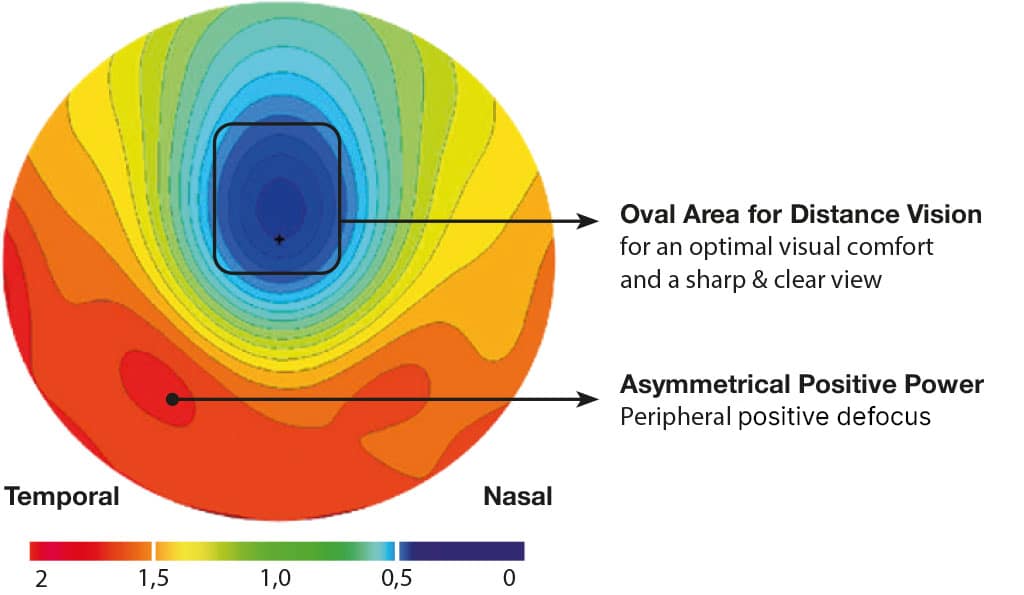
Who is eligible for myopia management? When is the best time to start? What is the best way to proceed? Questions upon questions – we will give you an answer.
nomy lenses contribute to conscientious and responsible myopia management, but there is more to it than just a high-quality product. In the following, we will discuss some important points in this regard.
Whether or not a measure to slow down myopia needs to be taken depends on an assessment of the individual risk of myopia development. The inheritance of myopia is an important indicator of potential progressive myopia: If one parent has high myopia, the risk of the child developing severe myopia is increased. This risk statistically increases further, if both parents are myopic. The age of the child at which myopia is measurable also provides an indication of how the myopia might develop. Generally, the younger the child, the more time the eye has to grow. Additionally the change in myopia within a year is an important factor. If myopia increases by half a dioptre or more in one year and/or if the eye has grown significantly more than normal during this period, myopia management should be considered as beneficial.
When is the best time to start? Measures should begin as soon as progressive myopia is detected or as soon as it can be predicted. In special cases this can even be before the first prescription of glasses. According to a study with 3,195 participants worldwide, experts believe that a refractive error of -0.50 dioptres or more and a minimum age of 6 years are the key indicators to start myopia management.
The results of myopia treatment vary from child to child and depend on numerous individual factors, not least the age and living conditions of the myopic child. The goal of any treatment strategy is to achieve axial length growth that corresponds to that of an emmetropic eye. Charts are useful tools that allow the tracking of axial growth progression in children using percentile curves. It seems certain that the chances of success are better and the measures are more effective when myopia management is started as early as possible. Currently no treatment option can completely cure or prevent the progression of myopia and the same measures are not equally effective for every child. In some cases different methods (lenses, contact lenses, atropine) can at least be temporarily combined to increase the chances of success in myopia management.
The World Council of Optometry recommends three fundamental steps as the standard for dealing with progressive myopia:
If myopia or a deviation in the growth of the eye length from the percentile curves is detected, the child should have a refraction test under cycloplegia by an ophthalmologist and, if necessary, initially receive single-vision glasses. If not done beforehand, it is now advisable to measure and document the axial eye length. After six months the relevant values and parameters of the child should be checked and documented again. At the latest after a year, if myopia progresses, myopia management with nomy lenses should begin.
The goal of refraction among myopic children should be to achieve the best possible visual acuity with the appropriate correction. Undercorrection is not recommended. It is important that certain parameters are documented for determining needs and during follow-up checks, and that the near-focusing response of the eye does not play a role: Therefore, accommodation must be deactivated during the examinations, which is done using drops (atropine). This cycloplegia is reserved for ophthalmologists! Only in this way can be for example an incorrect measurement of too high myopia be avoided and the back of the eye can be examined for abnormalities.
In addition to regular eye check-ups with a specialist there are easy-to-implement measures that can generally counteract progressive myopia and support the normal, healthy development of the eyes.
Spending at least 90 minutes – ideally two hours – outdoors in daylight each day helps even before the onset of myopia. Adequate outdoor activity has many benefits. In relation to myopia the alternating focus of the eyes on different distances and daylight positively affect the retina. Vitamin D intake plays an important role in this process. The light intensity outside in sunlight is many times higher even in the shade compared to typical indoor lighting. Current studies show that a lack of daylight can play a significant role in the development of myopia.
Avoiding prolonged near vision reduces stress on the eyes. Especially the constant focus on digital devices strains the eyes; regular breaks and looking into the distance provide relaxation. Each time one looks at a smartphone or tablet, the eyes adjust to a nearby point, which can lead to eye growth and thus progressive myopia in the long term. Reducing such near vision reduces this additional stimulus for eye length growth.
Education is important and a lot of near work is necessary for school. Therefore a sufficient reading and working distance is also important for the eyes during analogue visual tasks. This can already be increased by maintaining an upright posture while sitting. Additionally the simple 20-20-20 rule helps: every 20 minutes, focus on an object about six metres (20 feet) away for 20 seconds!
The standard for the treatment of myopia according to the World Council of Optometry recommends follow-up appointments after one month, six months, and then (recurrently) annually. The following measures are recommended during each of these check-ups:
Analyse patient history / Assess satisfaction with the glasses / Accommodation measurement (objective) / Verification of optimal vision correction / General examination of the eye and fundus / Axial length measurement of the eye
Accommodation measurement and fundoscopy are not always feasible for optometrists. In such cases alternative examinations can be conducted to monitor the progression of myopia, such as Mohindra retinoscopy, which is performed in the dark or corneal curvature measurement. For the aforementioned reasons collaboration with an ophthalmologist is recommended for effective myopia management.
According to the recommendations of the World Council of Optometry the treatment of progressive myopia should be continued until the end of childhood and even into early adulthood to prevent progression or rebound effects and a later onset. Myopia usually develops between the ages of 5 and 16. The eye typically stops growing around the age of 20.

We have been manufacturing lenses with the highest precision and innovative strength in Germany since 1935.
We not only ensure that you simply see better and more with our products. For years we have been developing lenses that provide optimum protection for your eyes. This includes e. g. our UV and infrared protection coating as well as innovative lens materials that filter blue light and increase contrasts.
With one of the most modern European machine setups, we stand for advanced products with the highest quality standards at fair prices.
You can purchase WETZLICH lenses from your local optician. Simply ask him about our lenses or find a WETZLICH partner optician in our optician search.
You need to load content from reCAPTCHA to submit the form. Please note that doing so will share data with third-party providers.
More InformationYou are currently viewing a placeholder content from Facebook. To access the actual content, click the button below. Please note that doing so will share data with third-party providers.
More InformationYou are currently viewing a placeholder content from Google Maps. To access the actual content, click the button below. Please note that doing so will share data with third-party providers.
More InformationYou are currently viewing a placeholder content from Instagram. To access the actual content, click the button below. Please note that doing so will share data with third-party providers.
More Information